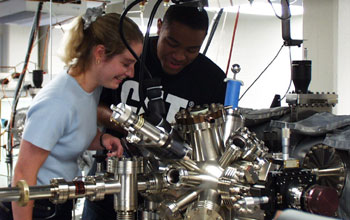Multimedia Gallery
Observing the Nanostructure of Chloroplast
Observing the Nanostructure of Chloroplast
Researchers Erica Elvey and Byron Williams of the Nanoscience Program at the University of Arkansas, use scanning probe microcopy to observe the nanostructure of chloroplast. As physical scientists, they are both attempting to apply tools normally reserved for the spatial and temporal exploration of nanostructures in physics and materials science to obtain unprecedented spatial images of biological nanoscale structures. In turn, biology offers to the physical sciences an enormous range of compelling questions. It also offers the opportunity to think about hybrid systems that combine biological and non-biological components. As a result, their effort will provide unprecedented detail in visual images that will be the genesis of substantial new insight into the role of nanoscale structures in the functioning of biological Systems.
The Arkansas Nanoscience Program is sponsored by the National Science Foundation's EPSCoR (Experimental Program to Stimulate Competitive Research) activity. EPSCoR is a joint program between NSF and several U.S. states and territories that promotes the development of science and technology resources through partnerships between the state's research community and NSF. EPSCoR operates on the principle that aiding researchers and institutions in securing federal funding develops the state's research infrastructure and advances economic growth. EPSCoR seeks to maximize the potential inherent in the state's science and technology resources and to use those resources as a foundation for economic growth. Further information about the Arkansas EPSCoR activity is available at http://www.uark.edu/~epscor/index.html. (Date of Image: 2004)
Credit: Nanoscience Program, University of Arkansas
Images and other media in the National Science Foundation Multimedia Gallery are available for use in print and electronic material by NSF employees, members of the media, university staff, teachers and the general public. All media in the gallery are intended for personal, educational and nonprofit/non-commercial use only.
Images credited to the National Science Foundation, a federal agency, are in the public domain. The images were created by employees of the United States Government as part of their official duties or prepared by contractors as "works for hire" for NSF. You may freely use NSF-credited images and, at your discretion, credit NSF with a "Courtesy: National Science Foundation" notation.
Additional information about general usage can be found in Conditions.
Also Available:
Download the high-resolution JPG version of the image. (476 KB)
Use your mouse to right-click (Mac users may need to Ctrl-click) the link above and choose the option that will save the file or target to your computer.

